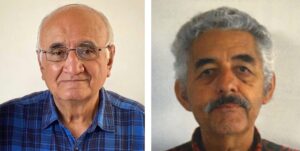
By David Agren
(OSV News) — The suspect in the June 2022 slaying of two elderly Jesuit priests and a man they were sheltering in their parish has been found dead after being killed execution-style. Such an end to a case — for which the Society of Jesus expressed deep dissatisfaction — reinforced Mexico’s reputation for impunity and rampant violence in regions controlled by drug cartels.
The death of the suspect, José Noriel Portillo Gil, “in no way can be considered a triumph for justice, or a solution to the structural problem of violence” in the Sierra Tarahumara region, the Jesuit province in Mexico said in a statement.
“The lack of an adequate legal process in the murder case would only imply the Mexican government has failed in its basic duties and confirm that the authorities do not have control of the territory,” the Jesuits wrote March 23, referring to the region where the priests worked.
“This shows that we are facing more barbarism and the failure of our institutions,” Jesuit provincial Father Luis Gerardo Moro Madrid said in a social media statement March 26.
“Everything seemed, like a ‘settling of scores’ or thinking, ‘that a person was hindering other interests and that is why he had to be eliminated,'” the Diocese of Tarahumara added in a statement.
The body of Gil, known as “El Chueco” or “The Crooked One,” had been possibly found in the western state of Sinaloa, Mexican President Andrés Manuel López Obrador said at the press conference March 23. He confirmed Gil’s identity the next day. Gil had been shot execution-style at short range, according to press reports.
Fathers Javier Campos and Joaquin Mora were murdered in their parish in the community of Cerocahui, which serves the indigenous Tarahumara population. The priests were killed while sheltering a local tour guide, Pedro Palma, who was chased by Gil into the parish.
The killings of two Jesuits reinforced Mexico’s status as one of the world’s most murderous countries for Catholic priests. At least seven Mexican priests have been murdered since López Obrador took office in December 2018, according to the Catholic Multimedia Center in Mexico City.
Increasing numbers of Catholic clergy subsequently spoke out on violence in their dioceses — including bishops, many of whom had previously preferred discretion on the issue. Many called for the president to reconsider his security strategy of “hugs, not bullets” — a slogan from his successful 2018 campaign.
“Hugs are not enough to stop bullets,” Jesuit Father Javier Ávila said at the priests’ funeral Mass.
President López Obrador refused to change his security strategy. He later accused the country’s bishops of failing to follow the teaching of Pope Francis and “acting in cahoots with the Mexican oligarchy.”
Mexico has continued to make scandalous headlines for drug cartel violence — such as the March attack on four U.S. citizens in the border city of Matamoros, which claimed three lives — though López Obrador insisted March 24: “In Mexico there are no massacres.”
He insisted that no parts of Mexico are under control of drug cartels, in response to comments from U.S. Secretary of State Anthony Blinken asserting the contrary. Catholics in conflictive corners of the country disagreed.
“We’re experiencing a sad situation because, as we say in the Sierra, the disaster here was not provoked by a single person; rather, unfortunately, a structure exists of extortion, bribery, clandestine alcohol sales, illegal logging, etc,” the Diocese of Tarahuamara said in a March 23 statement signed by Bishop Juan Manuel González Sandoval. “It’s a structure that everyone, citizens and especially the authorities must do away with.”
Gil had become notorious in the Sierra Tarahumara for running a criminal organization linked to the Sinaloa Cartel, which ran drugs, charged extortion, and controlled illegal logging, according to the authorities.
“The government had this criminal perfectly located, where he moved, what he did,” Father Ávila, who has worked in the Sierra Tarahumara for 48 years, told OSV News. “If they had located him, why did they never detain him? Why did he fall off the map at the time of the homicides?” he asked.
